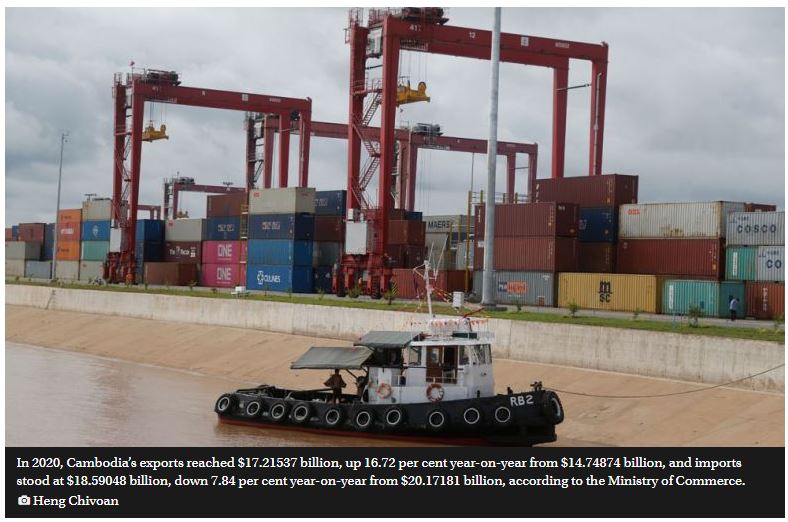Cambodia: Non-gold goods trade exceeds $29B
Cambodia’s global non-gold goods trade topped $29 billion in the first three quarters of 2021, increasing by around a quarter year-on-year, the Ministry of Economy and Finance reported.
The Kingdom’s international trade has remained in positive growth territory even as the economy continues to be under stress from the Covid-19 crisis – especially after the February 20 community event – which exerts pressure on key indicators of economic growth, the ministry said in its latest Socio-Economic Trends Report.
In the January-September period, non-gold goods exports reached nearly $12.69 billion, up by 23 per cent year-on-year, driven by textiles, bicycles, furniture, fur skins, rubber, plank boards, solar panels, wiring and wiring components, and electronic and agricultural products.
The analogous imports amounted to $16.5 billion – equivalent to 57.6 per cent of gross domestic product (GDP) – up by 26.5 per cent year-on-year, mainly buoyed by fabrics, construction materials and fuel. This indicates a trade deficit of nearly $4 billion.
The ministry said: “Cambodia’s economy is expected to grow positively in 2021 due to the recovery of the global economic situation, the economy of Cambodia’s trading partners, coupled with a boost from a number of sectors such as agriculture, non-garment manufacturing, transportation and communication, and the availability of orders and garment factories diverted from Myanmar to Cambodia.
Royal Academy of Cambodia economics researcher Ky Sereyvath held that the increase in imports and exports confirms the robustness of the Kingdom’s production chains, even during the peaks of Covid surges.
He suggested that the hike in exports were likely due to factors such as increased domestic production capacity and orders from major international partners, while production chains in some countries faced greater disruptions from the Covid-19 crisis.
He also put forward that the bump in imports was mainly due to purchases of raw materials for garment production.
“Although these numbers are not as high as they were in 2019, it is a good sign for Cambodia’s economic growth. The resulting trade deficit is not a concern, we cannot take this balance as a barometer.
“In fact, the US trade balance has been negative since 1945,” Sereyvath told The Post on December 21.
He explained that a country’s balance of payments (BOP) is made up of a current account, capital account and financial account, which together paint a better picture of the state of an economy.
Although Sereyvath firmly believes that the spread of the SARS-CoV-2 Omicron variant will negatively impact global trade, he contends that Cambodian exports would take a lighter hit, saying they predominantly comprise daily use products such as clothes, raw materials and agricultural products.
Cambodia Chamber of Commerce vice-president Lim Heng noted that imports and exports continued to grow even as the February 20 community outbreak prompted the government to lock down some areas, factories and manufacturing enterprises.
He argued that this was a sign that Cambodian products are gaining a lot of support from the international market.
“In addition, Cambodia expects that the introduction of new investment laws and trade facilitation procedures, as well as the promulgation of bilateral and multilateral free trade agreements, will help secure more orders from now on,” Heng said.
In 2020, the Kingdom’s exports reached $17.21537 billion, up 16.72 per cent year-on-year from $14.74874 billion, and imports stood at $18.59048 billion, down 7.84 per cent year-on-year from $20.17181 billion, according to the Ministry of Commerce.
A current account consists of transactions covering the flow of goods and services in and out of a country, including tangible items, service fees, cross-border income associated with the international ownership of financial assets, business process outsourcing and tourism receipts, and unrequited transfers such as remittances and foreign aid.
A capital account records, among other things, the inflows and outflows of capital that affect a country’s external assets and liabilities without directly affecting income, savings or production, such as for sales involving non-produced, non-financial assets including natural resources like land and mineral reserves, and intangibles like patents, trademarks, goodwill, leases and other transferable contracts.
It also covers capital taxes; debt assumption and forgiveness; the transfer of goods and financial assets by migrants entering or leaving a country; investment grants; and extraordinary claims associated with non-life insurance.
A financial account tracks shifts in the international ownership of real and financial assets and liabilities. It consists of two major subaccounts: the domestic ownership of foreign assets and the foreign ownership of domestic assets.
Source: https://www.phnompenhpost.com/business/non-gold-goods-trade-exceeds-29b


 Thailand
Thailand




